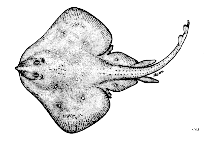Leucoraja circularis (Couch, 1838)
Sandy ray
個人による観察記録の追加 Fish Watcher
| Native range | All suitable habitat | Point map | Year 2050 |

|
| This map was computer-generated and has not yet been reviewed. |
| Leucoraja circularis AquaMaps Data sources: GBIF OBIS |
Common names from other countries
分類 / Names 共通名の | 類義語 | Catalog of Fishes(部類, 種) | ITIS | CoL | WoRMS | Cloffa
板鰓亜鋼(サメとエイ類) (sharks and rays) > Rajiformes (Skates and rays) > Rajidae (Skates)
Etymology: Leucoraja: Greek, leykos = white + Latin, raja = a fish, Raja sp. (Ref. 45335).
Etymology: Leucoraja: Greek, leykos = white + Latin, raja = a fish, Raja sp. (Ref. 45335).
Environment: milieu / climate zone / depth range / distribution range 生態学
海 底生の; 深さの範囲 10 - 800 m (Ref. 106604). Temperate; 67°N - 27°N, 25°W - 37°E
分布 国々 | 国連食糧農業機関の区域 | エコシステム | 事件 | Point map | 導入 | Faunafri
Eastern Atlantic (Iceland, southern Norway, Skagerrak and Morocco) and the Mediterranean Sea.
Records as far south to Mauritania and Senegal could not be verified due to lacking descriptions and specimens; most are probably misidentifications of Leucoraja leucosticta.
サイズ / 重さ / 年齢
Maturity: Lm ? range ? - ? cm
Max length : 120 cm TL オス/雌雄の選別がない; (Ref. 4426); 117.0 cm TL (female); common length : 70.0 cm TL オス/雌雄の選別がない; (Ref. 4426)
Max length : 120 cm TL オス/雌雄の選別がない; (Ref. 4426); 117.0 cm TL (female); common length : 70.0 cm TL オス/雌雄の選別がない; (Ref. 4426)
簡単な記述 検索表 | 形態学 | 形態計測学
背面の脊椎 (合計) : 0; 肛門の骨: 0. Snout short, its tip somewhat pronounced; upper surface entirely spinulose, about 8 thorns generally in a complete row around inner margin of eye and a triangle of thorns on nape or shoulder region; underside with prickles only on snout, between gill-slits, along abdomen, and at anterior margins of disc; tail only slightly longer than body; upper surface reddish-brown to dark brown with 4-6 creamy spots on each wing, underside white (Ref. 3167).
Found in offshore shelf waters and on upper slope, mainly around the 100 m line (Ref. 3167). Depth range from 70-275 m (Ref. 03167), and from 463-676 m in eastern Ionian Sea (Ref. 56504). Feed on all kinds of bottom animals (Ref. 3167). Oviparous. Distinct pairing with embrace. Young may tend to follow large objects, such as their mother (Ref. 205). Eggs are oblong capsules with stiff pointed horns at the corners deposited in sandy or muddy flats (Ref. 205). Egg capsules are 8.3-9.2 cm long and 4.6-5.3 cm wide (Ref. 41303, 41251, 41311). Maximum length for female is 117 cm (Ref. 41333).
Life cycle and mating behavior 成熟 | 繁殖 | 放精 | 卵 | 生産力 | 幼生
Oviparous, paired eggs are laid. Embryos feed solely on yolk (Ref. 50449). With no definite egg laying period (Ref. 3167). Distinct pairing with embrace. Young may tend to follow large objects, such as their mother (Ref. 205).
主な参考文献
Upload your references | 参考文献 | コーディネーター : McEachran, John | 協力者
McEachran, J.D. and K.A. Dunn, 1998. Phylogenetic analysis of skates, a morphologically conservative clade of elasmobranchs (Chondrichthyes: Rajidae). Copeia 1998(2):271-290. (Ref. 27314)
人間に対する脅威
Harmless
Human uses
水産業: 少数商業の
FAO(水産業: 代謝; publication : search) | FishSource | 私達の周りの海
より多くの情報
Population dynamics
成長のパラメーター
Max. ages / sizes
Length-weight rel.
Length-length rel.
体長組成
Mass conversion
補充
豊度
成長のパラメーター
Max. ages / sizes
Length-weight rel.
Length-length rel.
体長組成
Mass conversion
補充
豊度
Physiology
Body composition
Nutrients
酸素消費
水泳形態
泳ぐ速さ
Visual pigments
Fish sound
Diseases & Parasites
Toxicity (LC50s)
Body composition
Nutrients
酸素消費
水泳形態
泳ぐ速さ
Visual pigments
Fish sound
Diseases & Parasites
Toxicity (LC50s)
用具
E-book | 野外観察図鑑 | 検索表 | Length-frequency wizard | 生活史の基盤ツール | 目的のマップ | Classification Tree
| Catch-MSY |
特記事項
XMLをダウンロードして下さい
インターネットの情報源
Aquatic Commons | BHL | Cloffa | Websites from users | Check FishWatcher | CISTI | Catalog of Fishes(部類, 種) | DiscoverLife | ECOTOX | Faunafri | Fishtrace | GenBank(ゲノム, ヌクレオチド) | GloBI | GOBASE | | Google Books | Google Scholar | Google | IGFA World Record | MitoFish | 国のデーターベース | Otolith Atlas of Taiwan Fishes | PubMed | Reef Life Survey | Scirus | SeaLifeBase | 生命の木 | Wikipedia(行く, 検索する) | World Records Freshwater Fishing | 動物に関する記録
Estimates based on models
Preferred temperature (Ref. 115969): 7.5 - 14.2, mean 11.3 (based on 116 cells).
Phylogenetic diversity index (Ref. 82804): PD50 = 0.5000 [Uniqueness, from 0.5 = low to 2.0 = high].
Bayesian length-weight: a=0.00269 (0.00166 - 0.00436), b=3.20 (3.06 - 3.34), in cm Total Length, based on LWR estimates for this species & Genus-body shape (Ref. 93245).
栄養段階 (Ref. 69278): 3.5 ±0.37 se; based on food items.
回復力 (Ref. 120179): 低い, 4.5年~14年の倍増期間の最小個体群 (Fec assumed to be <100).
Fishing Vulnerability (Ref. 59153): High to very high vulnerability (72 of 100).
Climate Vulnerability (Ref. 125649): Moderate to high vulnerability (48 of 100).




